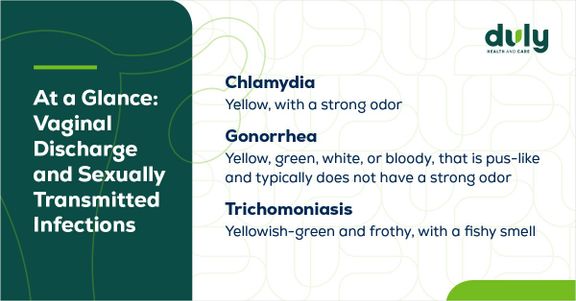Raise your hand if you’ve ever looked down at your underwear and seen discharge.
If you were in a room full of women asked to do the same thing, chances are that you would see plenty of hands go up.
But what exactly is vaginal discharge — and what does it say about your health?
Here are five things that your vaginal discharge may be telling you:
1. Your vagina is healthy and functioning correctly.
Some vaginal discharge is completely normal — and it’s even a good thing.
Discharge, which contains old cells that lined the vagina, is one way in which your vagina cleans itself. It also plays a role in protecting you from infections in your vagina or vulva (your external genital organs).
Normal vaginal discharge is usually clear or milky. It can change in thickness and amount with your menstrual cycle. For example, you may notice that it is thicker during ovulation (when your ovaries release eggs), when you’re sexually aroused, or while breastfeeding. After menopause, you may have less as your estrogen levels decrease.
Also, while a little bit of vaginal odor is normal for many women, healthy discharge doesn’t smell bad or have a noticeable odor.
Not sure if you have normal vaginal discharge? Schedule an appointment with a Duly Health and Care gynecologist.
2. You have a yeast infection.
Vaginal discharge that is thick, white, and resembles cottage cheese may be a sign of a yeast infection. This discharge is also usually odorless and may be watery.
Yeast infections are caused by an overgrowth of the fungus candida, which is often due to pregnancy, diabetes, antibiotic or corticosteroid use, or hormonal birth control that’s high in estrogen. While it’s not technically considered to be a sexually transmitted infection (STI), you can get the infection from a sexual partner.
Yeast infections are incredibly common among women after puberty and before menopause. In fact, three out of four women will experience one of these infections at some point, and about half will have two or more.
Discharge is only one of the symptoms associated with yeast infections. The most common symptom is itchiness around and in your vagina. You may also have burning, pain while urinating or having sex, or redness and swelling.
The good news is that yeast infections are generally easy to treat. Once you have confirmed with your provider that it is a yeast infection and not a different type of infection, you can use over-the-counter antifungal creams or your provider may give you a one-time antifungal pill to take by mouth.
3. You have a sexually transmitted infection.
Certain types of sexually transmitted infections (STIs) — infections that are transmitted between partners during sexual contact — can also cause vaginal discharge. The appearance of the discharge depends on which type of STI is the culprit.

If you find out that you have an STI, it’s important to treat it so that it doesn’t lead to further health problems, such as pelvic inflammatory disease — a disease that can cause infertility or ectopic pregnancy. It’s also critical to take steps to avoid passing the infection on, like using condoms and having your partner get tested.
Did you know that you can get tested for STIs in our Immediate Care Centers?
4. You have bacterial vaginosis.
Vaginal discharge that is gray or milky white, foamy or watery, or has a strong fish-like smell — especially after having sex — could point to bacterial vaginosis.
Normally, the vagina has both good and harmful bacteria. When balanced healthily, they work together to maintain an acidic environment in your vagina that protects you from vaginal irritation or infections.
Bacterial vaginosis is an infection that occurs when that balance is disrupted and there is more harmful bacteria than good. It’s treatable with antibiotics.
While bacterial vaginosis is not a sexually transmitted infection, it is particularly common among people who are sexually active. This is because having sex without condoms or having a new or multiple sexual partners can upset the bacteria balance.
You can also get bacterial vaginosis by using douches (cleaning products are usually pre packaged mixes containing water and iodine, baking soda, or vinegar) or scented sprays. You might think you’re cleaning your vagina, but these products actually do much more harm than good. They can throw your bacteria balance out of whack, causing bacterial vaginosis and potentially leading to problems ranging from an increased risk of getting an STI to serious problems during pregnancy.
The trick to real hygiene? Wash the outside of your vagina with warm water and then let your vagina do its own thing. Remember, your vagina has mechanisms for cleaning itself.
5. There’s something more serious going on.
Abnormal discharge usually isn’t a major cause for concern. It can often be chalked up to a treatable infection or using certain hygiene products.
However, in rare cases, unusual discharge could be a sign of a more serious problem, like a vaginal cancer.
See your provider if your discharge is accompanied by:
Pelvic pain
Fever
Bloody discharge (unrelated to your menstrual period)
Stool in the discharge
Also, make sure to see your provider if you have discharge after going through menopause. This could be a warning sign of cancer or a precancerous condition.
Whenever you have a question about your discharge — or your pelvic health in general — don’t hesitate to reach out to your women’s health provider. They can make sure that you’re on the right path toward keeping your vagina healthy.
Health Topics:








